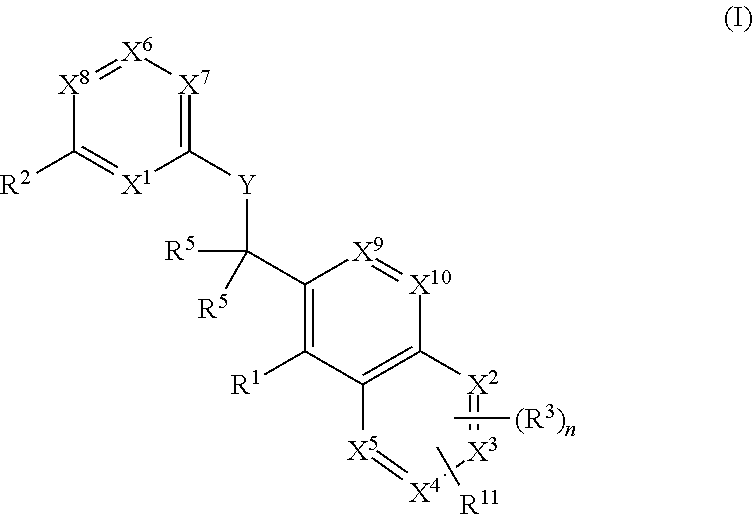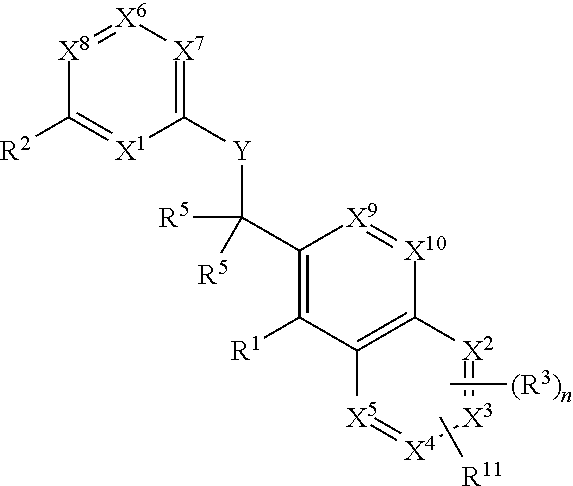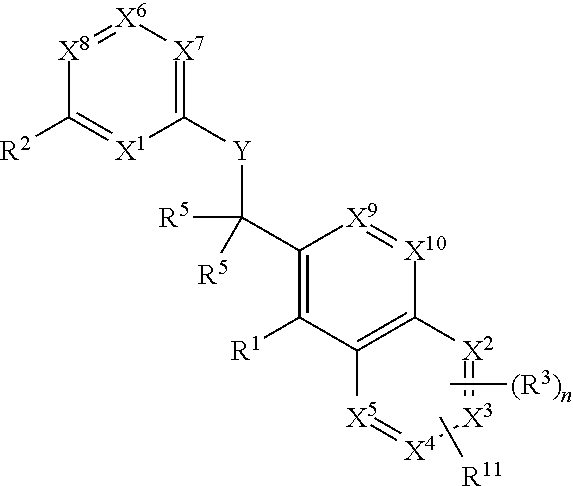Heterocyclic compounds and their uses
a technology of heterocyclic compounds and compounds, applied in the field of heterocyclic compounds and their, can solve the problems of limited utility of these compounds in studying the roles of individual class i pi 3-kinases, compounds, and non-specific pi3k inhibitors
- Summary
- Abstract
- Description
- Claims
- Application Information
AI Technical Summary
Benefits of technology
Problems solved by technology
Method used
Image
Examples
specific examples
Specific Example of General Method A1
1-(4-Chloroquinolin-3-yl)ethanol
[0205]
[0206]To a solution of 4-chloroquinoline (1.636 g, 10.00 mmol) in THF (100 mL) at −78° C. was added freshly prepared 1M lithium diisopropylamide (11 mL, 11 mmol, 1.1 eq). After stirring for 20 min, acetaldehyde (1.694 mL, 30.0 mmol) was added and the reaction was stirred at −78° C. for 1 h. The reaction was quenched with 50% sat NH4Cl, warmed to rt and diluted with ethyl acetate. The layers were separated and the organic layer was washed with brine, dried over MgSO4, filtered, and concentrated to afford 1-(4-chloroquinolin-3-yl)ethanol. 1H NMR (500 MHz, CDCl3) δ ppm 9.10 (s, 1H), 8.22 (d, J=8.6 Hz, 1H), 8.10 (d, J=8.3 Hz, 1H), 7.73 (ddd, J=8.3, 7.1, 1.5 Hz, 1H), 7.64 (ddd, J=8.1, 6.8, 1.0 Hz, 1H), 5.56 (q, J=6.6 Hz, 1H), 2.79 (br s, 1H), 1.62 (d, J=6.6 Hz, 3H).
2-(1-(4-Chloroquinolin-3-yl)ethyl)isoindoline-1,3-dione
[0207]
[0208]To a solution of phthalimide (0.527 g, 3.58 mmol), triphenylphosphine (0.940 g, 3.58...
example 1
4-Amino-6-((1-(4-(4-fluorophenyl)-3-quinolinyl)ethyl)amino)-5-pyrimidinecarbonitrile
[0215]
[0216]A reaction flask containing 4-amino-6-chloropyrimidine-5-carbonitrile (83 mg, 0.537 mmol), 1-(4-(4-fluorophenyl)quinolin-3-yl)ethanamine (135 mg, 0.507 mmol), and DIEA (177 μL, 1.014 mmol) in 1-butanol (5069 μL) was heated to 120° C. After the reaction was judged to be complete by LC / MS, the mixture was cooled to rt and filtered. The resulting solid was washed with ethanol to afford 4-amino-6-((1-(4-(4-fluorophenyl)-3-quinolinyl)ethyl)amino)-5-pyrimidinecarbonitrile. 1H NMR (500 MHz, CDCl3) δ ppm 9.01 (s, 1H), 8.13 (d, J=8.3 Hz, 1H), 8.00 (s, 1H), 7.69 (ddd J=8.1, 6.4, 1.2 Hz, 1H), 7.58 (m, 1H), 7.45 (m, 1H), 7.38 (m, 1H), 7.30-7.22 (series of m, 3H), 5.54 (d, J=6.6 Hz, 1H), 5.35-5.25 (series of m, 3H), 1.53 (d, J=7.1 Hz, 3H). Mass Spectrum (ESI) m / e=385.1 (M+1). The individual enantiomers were obtained according to the methods described in General Method B4 to give 4-amino-6-(((1S)-1-(4-...
example 2
4-Amino-6-((1-(8-chloro-6-fluoro-4-(2-pyridinyl)-3-quinolinyl)-ethyl)amino)-5-pyrimidinecarbonitrile
[0217]
[0218]1-(8-Chloro-6-fluoro-4-(pyridin-2-yl)quinolin-3-yl)ethanamine (0.12 g, 0.398 mmol), N-ethyl-N-isopropylpropan-2-amine (0.514 g, 3.98 mmol), and 4-amino-6-chloropyrimidine-5-carbonitrile (0.074 g, 0.477 mmol) were combined in 4 mL of 1-butanol and then heated under N2 to 110° C. for 1 h. The solvents were removed under vacuum and the residue obtained was purified by column chromatography using a gradient of 60% ethyl acetate / hexane to 100% ethyl acetate. The fractions containing the product were combined and concentrated under vacuum to provide 4-amino-6-((1-(8-chloro-6-fluoro-4-(2-pyridinyl)-3-quinolinyl)ethyl)amino)-5-pyrimidinecarbonitrile as a light yellow solid. A mixture of isomers was observed in the proton NMR trace. 1H NMR (500 MHz, DMSO-d6) δ ppm 9.31 (1H, br. s.), 8.80 (1H, d, J=3.4 Hz), 7.97-8.12 (2.7H, m), 7.85 (0.8H, br. s.), 7.75 (0.8H, d, J=7.6 Hz), 7.65 (0....
PUM
| Property | Measurement | Unit |
|---|---|---|
| temperature | aaaaa | aaaaa |
| temperature | aaaaa | aaaaa |
| pH | aaaaa | aaaaa |
Abstract
Description
Claims
Application Information
 Login to View More
Login to View More - R&D
- Intellectual Property
- Life Sciences
- Materials
- Tech Scout
- Unparalleled Data Quality
- Higher Quality Content
- 60% Fewer Hallucinations
Browse by: Latest US Patents, China's latest patents, Technical Efficacy Thesaurus, Application Domain, Technology Topic, Popular Technical Reports.
© 2025 PatSnap. All rights reserved.Legal|Privacy policy|Modern Slavery Act Transparency Statement|Sitemap|About US| Contact US: help@patsnap.com



